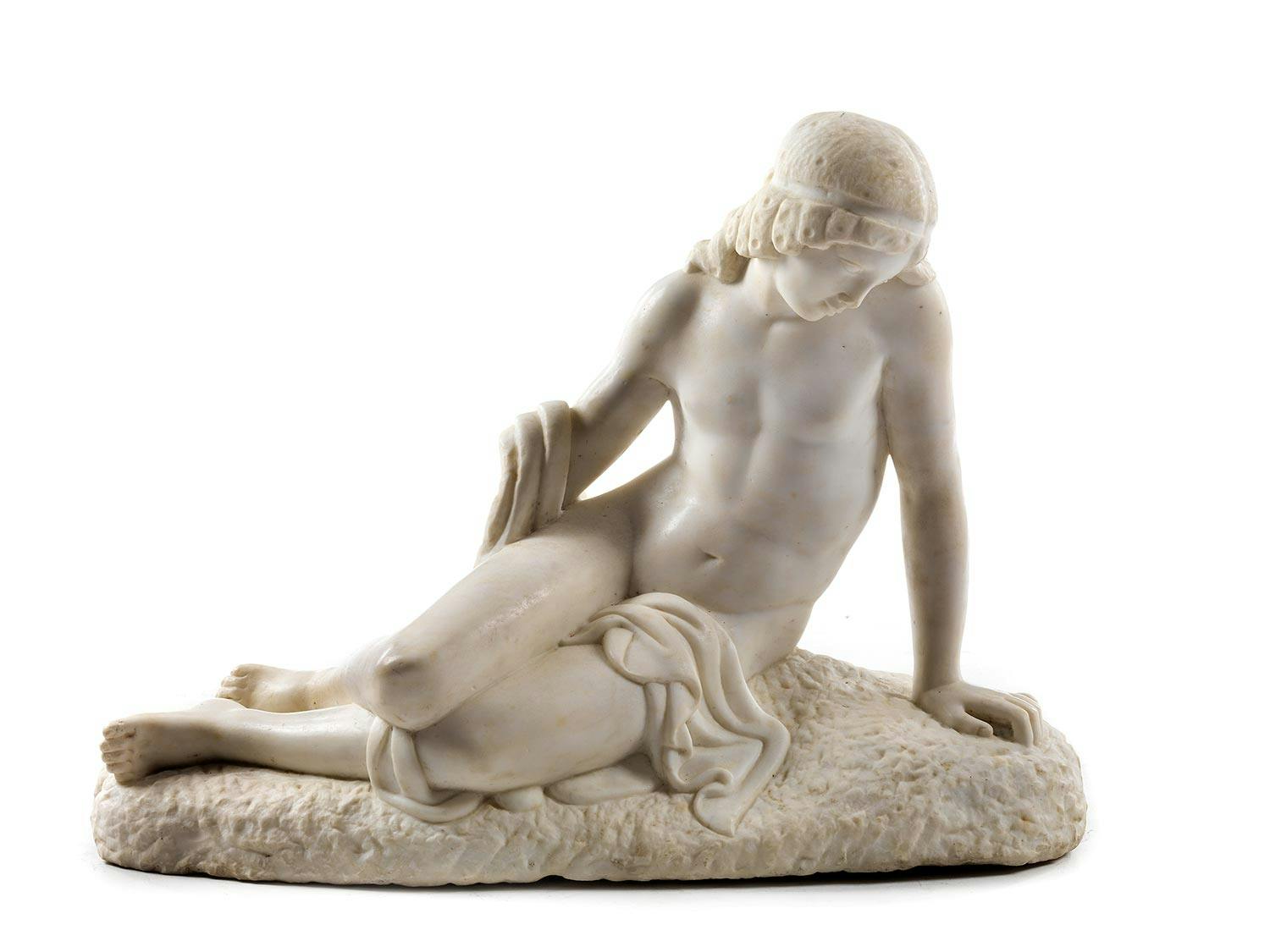DescriptionAdamo TadoliniItalian1788 - 1868Narcissus
signed and dated: Adamo Tadolini / fece 1851white marble, on a veined white marble base112 by 70 by 65cm., 44 by 27½ by 25½in.Condition reportFor further information on the condition of this lot please contact sculpture@sothebys.com.ProvenanceBonhams, London, 14 December 2016, European Collections, lot 84;Art market France;where acquired by the present ownerCatalogue noteThis beautiful marble figure of the Grecian youth Narcissus, who, according to Ovid, fell in love with his own reflection, finds its closest comparisons in a series of reclining and crouching figures by Adamo Tadolini's son Scipione. Compare, in particular, with Scipione's Susanna (1852); his famous Eva dope il peccato (before 1866); and the Odalisca dopo il bagno (circa 1860) (see Hufschmidt, op. cit., nos. S 4.- S 6.). All three figures share the same reclining pose and rockwork bases replete with leaves and rushes, whilst water features prominently in both the Eva and the Odalisca.
The pool of water has been used to dazzling effect in the present marble, with Narcissus peering down towards his reflection which emerges ingeniously from the ripples. Given the similarity between the present marble and Scipione Tadolini's female groups, it seems probable that the present Narcissus was carved at a time of transition in the Tadolini studio; when Scipione was taking over from his father Adamo. Scipione's influence probably explains the Romantic air to the present marble, which contrasts with Adamo's broadly Neoclassical output. The high quality of the carving is consistent with both Adamo and Scipione's oeuvres. The Narcissus is not recorded in any of the lists of works carved by Adamo. Given the similarity of the present marble with groups by Scipione Tadolini it should perhaps therefore be considered that the Narcissus was executed by Scipione under his father's supervision, with the Adamo Tadolini name being added as a 'brand' on completion.
Adamo Tadolini was Antonio Canova’s most trusted studio assistant, establishing an international reputation for himself as one of the last great Italian Neoclassical sculptors. Born in Bologna, he trained at the city’s Accademia di Belle Arte, where he received a rigorous education in the classical principles of sculpture. In 1814, he moved to Rome, winning the prize Canova had instituted for talented young sculptors. Impressed by Tadolini’s pure classicism, the master took him on as an assistant. Tadolini became so expert a marble carver that the versions he produced of his master’s models were (and still are) often thought to be originals by Canova himself; including, for example, the Cupid Reviving Psyche in the Villa Carlotta, Lake Como. As a sign of their closeness, Canova helped Tadolini to set up his own workshop in the Via dei Greci, which was eventually taken over by his son Scipione, and still exists to this day.
RELATED LITERATURET. F. Hufschmidt, Tadolini: Adamo, Scipione, Giulio, Enrico: Quattro generazioni di scultori a Roma nei secoli XIX e XX, Rome, 1996, pp. 202-206
DescriptionAdamo TadoliniItalian1788 - 1868Narcissus
signed and dated: Adamo Tadolini / fece 1851white marble, on a veined white marble base112 by 70 by 65cm., 44 by 27½ by 25½in.Condition reportFor further information on the condition of this lot please contact sculpture@sothebys.com.ProvenanceBonhams, London, 14 December 2016, European Collections, lot 84;Art market France;where acquired by the present ownerCatalogue noteThis beautiful marble figure of the Grecian youth Narcissus, who, according to Ovid, fell in love with his own reflection, finds its closest comparisons in a series of reclining and crouching figures by Adamo Tadolini's son Scipione. Compare, in particular, with Scipione's Susanna (1852); his famous Eva dope il peccato (before 1866); and the Odalisca dopo il bagno (circa 1860) (see Hufschmidt, op. cit., nos. S 4.- S 6.). All three figures share the same reclining pose and rockwork bases replete with leaves and rushes, whilst water features prominently in both the Eva and the Odalisca.
The pool of water has been used to dazzling effect in the present marble, with Narcissus peering down towards his reflection which emerges ingeniously from the ripples. Given the similarity between the present marble and Scipione Tadolini's female groups, it seems probable that the present Narcissus was carved at a time of transition in the Tadolini studio; when Scipione was taking over from his father Adamo. Scipione's influence probably explains the Romantic air to the present marble, which contrasts with Adamo's broadly Neoclassical output. The high quality of the carving is consistent with both Adamo and Scipione's oeuvres. The Narcissus is not recorded in any of the lists of works carved by Adamo. Given the similarity of the present marble with groups by Scipione Tadolini it should perhaps therefore be considered that the Narcissus was executed by Scipione under his father's supervision, with the Adamo Tadolini name being added as a 'brand' on completion.
Adamo Tadolini was Antonio Canova’s most trusted studio assistant, establishing an international reputation for himself as one of the last great Italian Neoclassical sculptors. Born in Bologna, he trained at the city’s Accademia di Belle Arte, where he received a rigorous education in the classical principles of sculpture. In 1814, he moved to Rome, winning the prize Canova had instituted for talented young sculptors. Impressed by Tadolini’s pure classicism, the master took him on as an assistant. Tadolini became so expert a marble carver that the versions he produced of his master’s models were (and still are) often thought to be originals by Canova himself; including, for example, the Cupid Reviving Psyche in the Villa Carlotta, Lake Como. As a sign of their closeness, Canova helped Tadolini to set up his own workshop in the Via dei Greci, which was eventually taken over by his son Scipione, and still exists to this day.
RELATED LITERATURET. F. Hufschmidt, Tadolini: Adamo, Scipione, Giulio, Enrico: Quattro generazioni di scultori a Roma nei secoli XIX e XX, Rome, 1996, pp. 202-206












Testen Sie LotSearch und seine Premium-Features 7 Tage - ohne Kosten!
Lassen Sie sich automatisch über neue Objekte in kommenden Auktionen benachrichtigen.
Suchauftrag anlegen